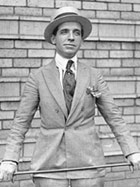
Charles Ponzi (1883-1949)
Charles Ponzi, an Italian immigrant living in Boston in the early twentieth century, was said by his worshipful followers to have "discovered money." In fact, what he really discovered was a way to bilk the public out of millions of dollars by means of a financial pyramid scheme. There were pyramid schemes before Ponzi came along, but his was so outrageous that this type of scam has ever since borne his name.
A Ponzi, or pyramid, scheme involves luring in investors with promises of high returns. The con artist invents a story to explain how the high returns are generated, but in reality he simply pays the first investors with money obtained from later investors. It's a take-from-Peter-to-pay-Paul system. As long as the scam artist manages to recruit larger and larger numbers of new investors (aka suckers) the system works, but as soon as the flow of new money stops, it collapses. Ponzi schemes always collapse, sooner or later.
Ponzi's System
Ponzi's bait to lure in investors was the idea that postal coupons purchased in Europe could be redeemed in America for six times their value, because of the difference in currency values. He established a company in late 1919 to take advantage of this discovery and invited people to invest with him, promising them that his scheme was so lucrative that they would double their money in ninety days.
On paper Ponzi's postal-coupon idea was plausible. After all, he was basically proposing a form of international currency trading (which is legal, and which people make money from all the time). But in practice his idea was hare-brained. It would have involved teams of agents buying up postal coupons in Europe, shipping them to America, and then taking them down to the post office to redeem them, one at a time. The cost of paying all these agents would quickly have eaten up any profits. Plus, in order for his idea to work he would have needed to redeem millions of postal coupons, but there were only a couple thousand of them in circulation.
Growth and Collapse
Ponzi had no intention of actually putting his idea into practice. He simply wanted as many people as possible to give him their money, and then let the pyramid scheme system go into effect.
At first people were skeptical, but when he actually began paying out returns to the early investors, a Ponzi-mania set in. Thousands of people lined up to give him cash. It's said that he had over 40,000 investors, allowing him to rake in somewhere in the region of $15 million by mid 1920.
The inevitable crash came in 1920 when newspapers and banks started to investigate him. Rumors of his criminal past emerged. Investors panicked and began withdrawing their money from his company. This caused the entire scheme to come crashing down like a house of cards.
Oddly enough, Ponzi didn't simply take the money and run. If he had been smarter, he would have. Instead he waited around until the police arrived and ended up being sentenced to five years in jail, of which he served three-and-a-half years.
Ponzi spent the rest of his life drifting in and out of trouble with the law. He died in Rio de Janeiro on January 18, 1949, penniless.
Links and References
- Mitchell Zuckoff. Ponzi's Scheme: The True Story of a Financial Legend. Random House. 2005.


Comments